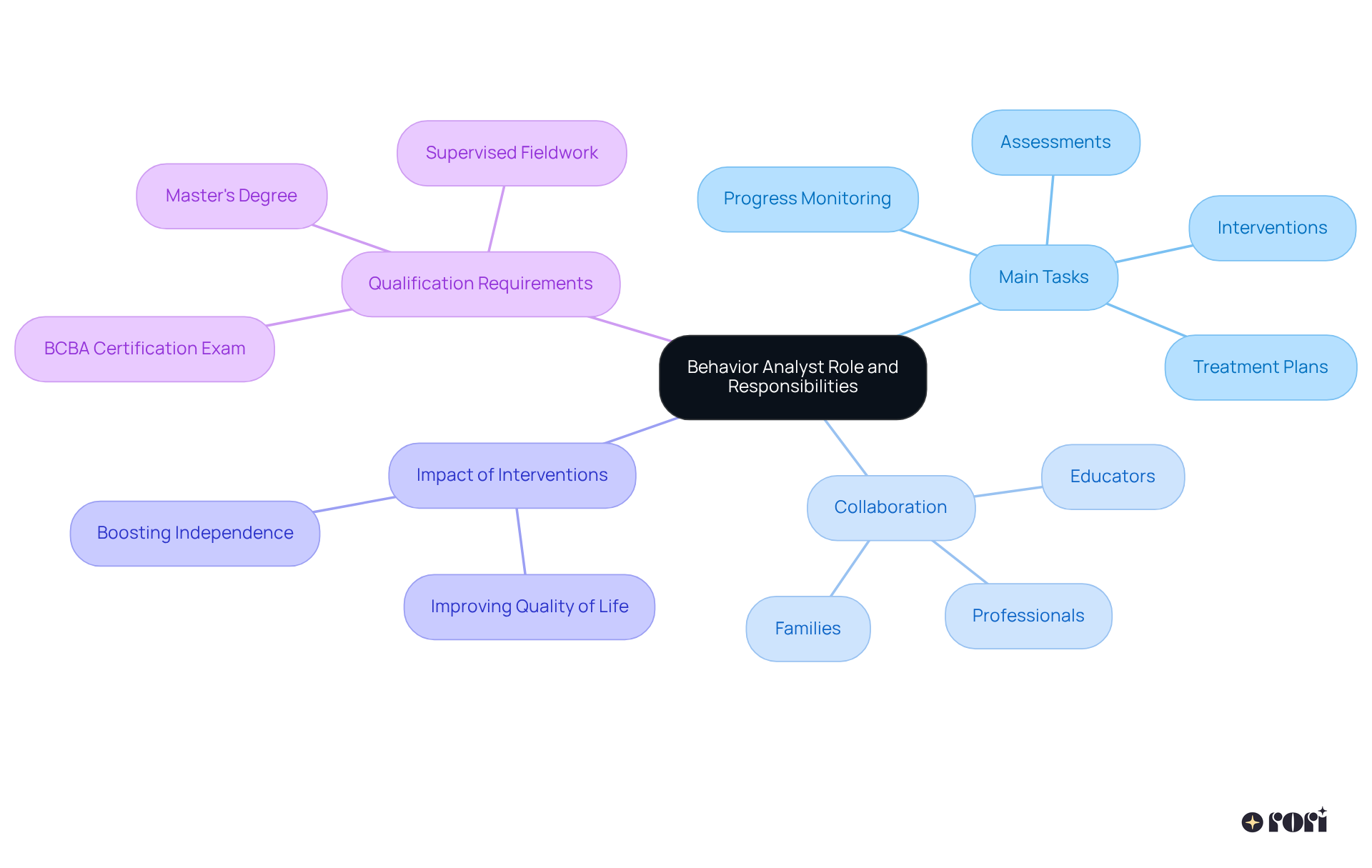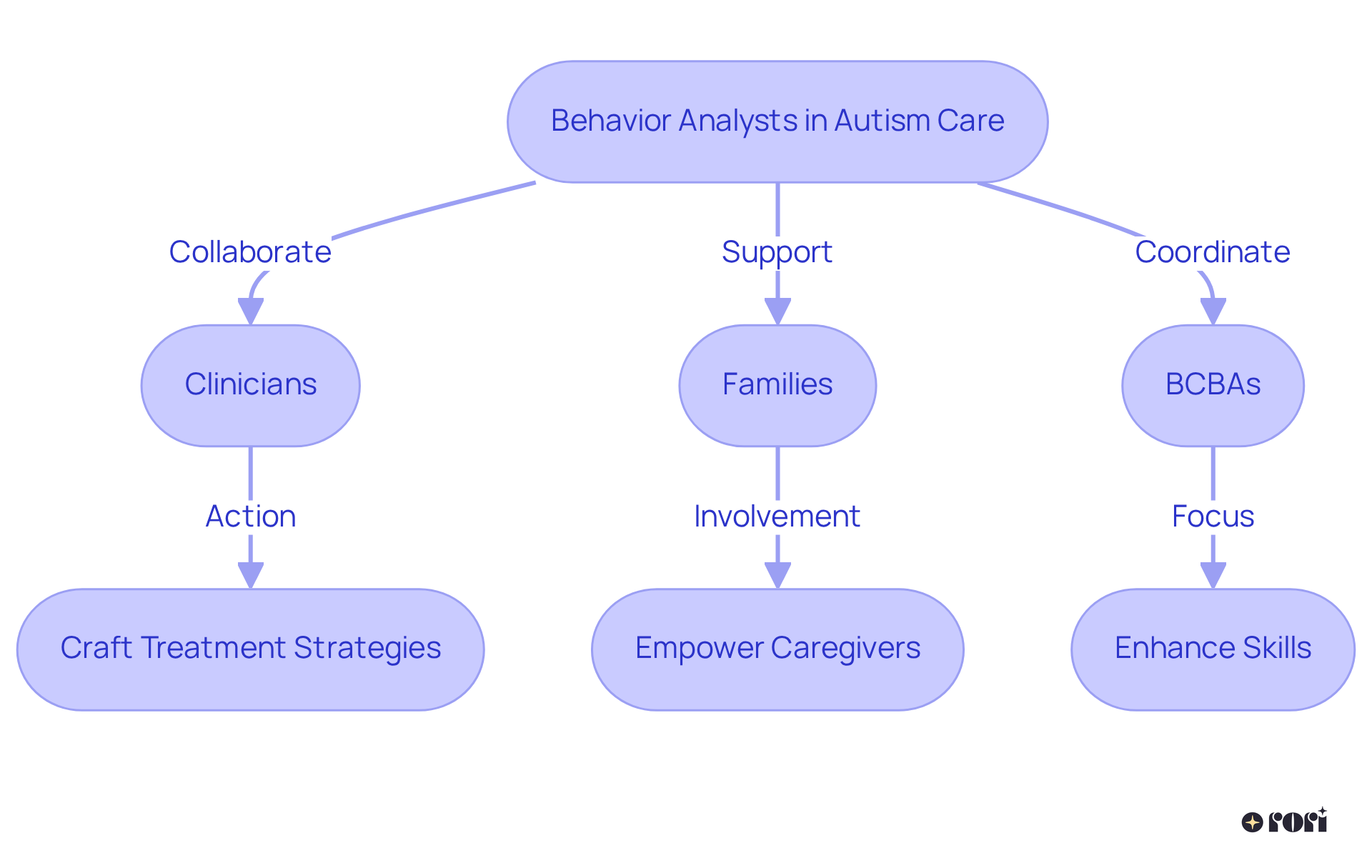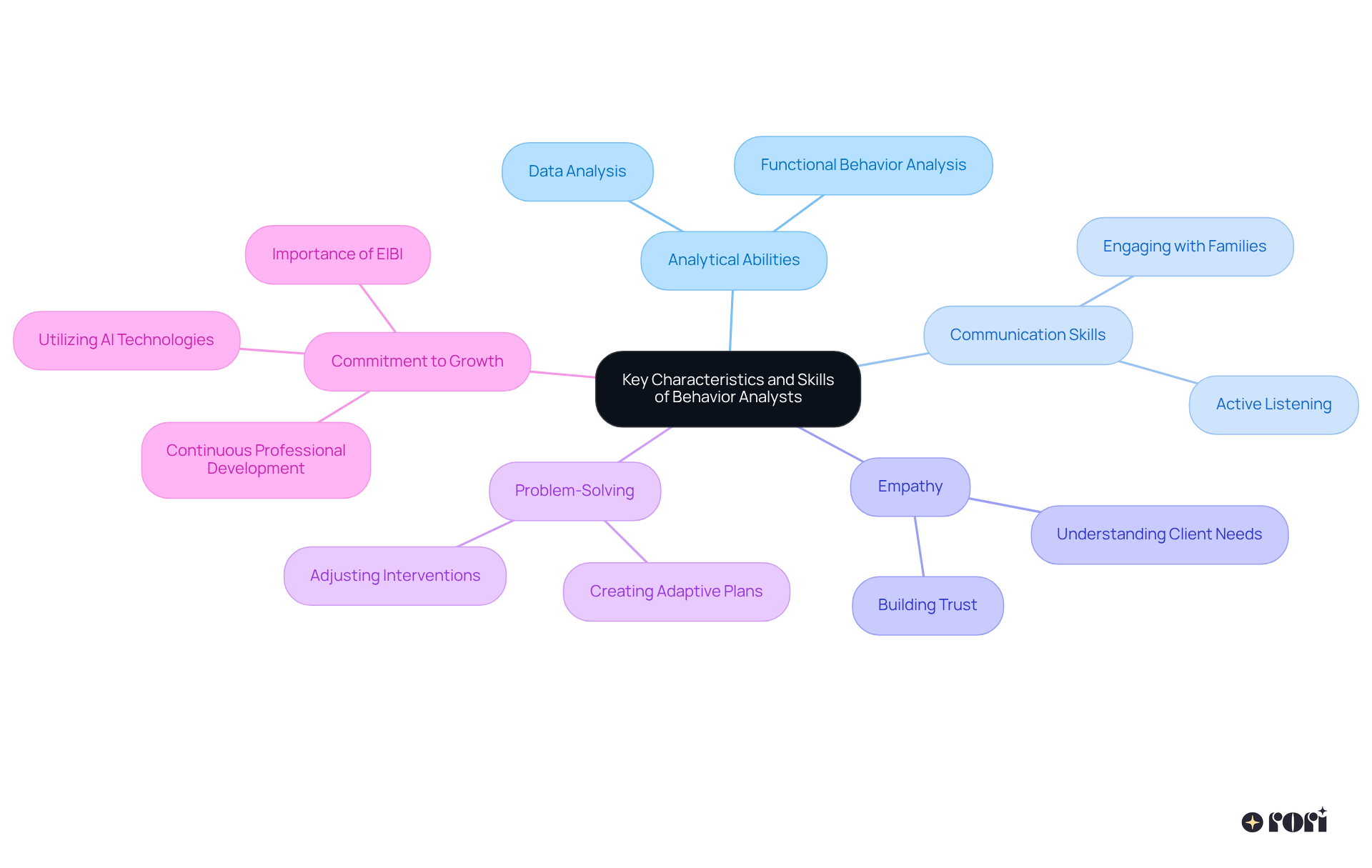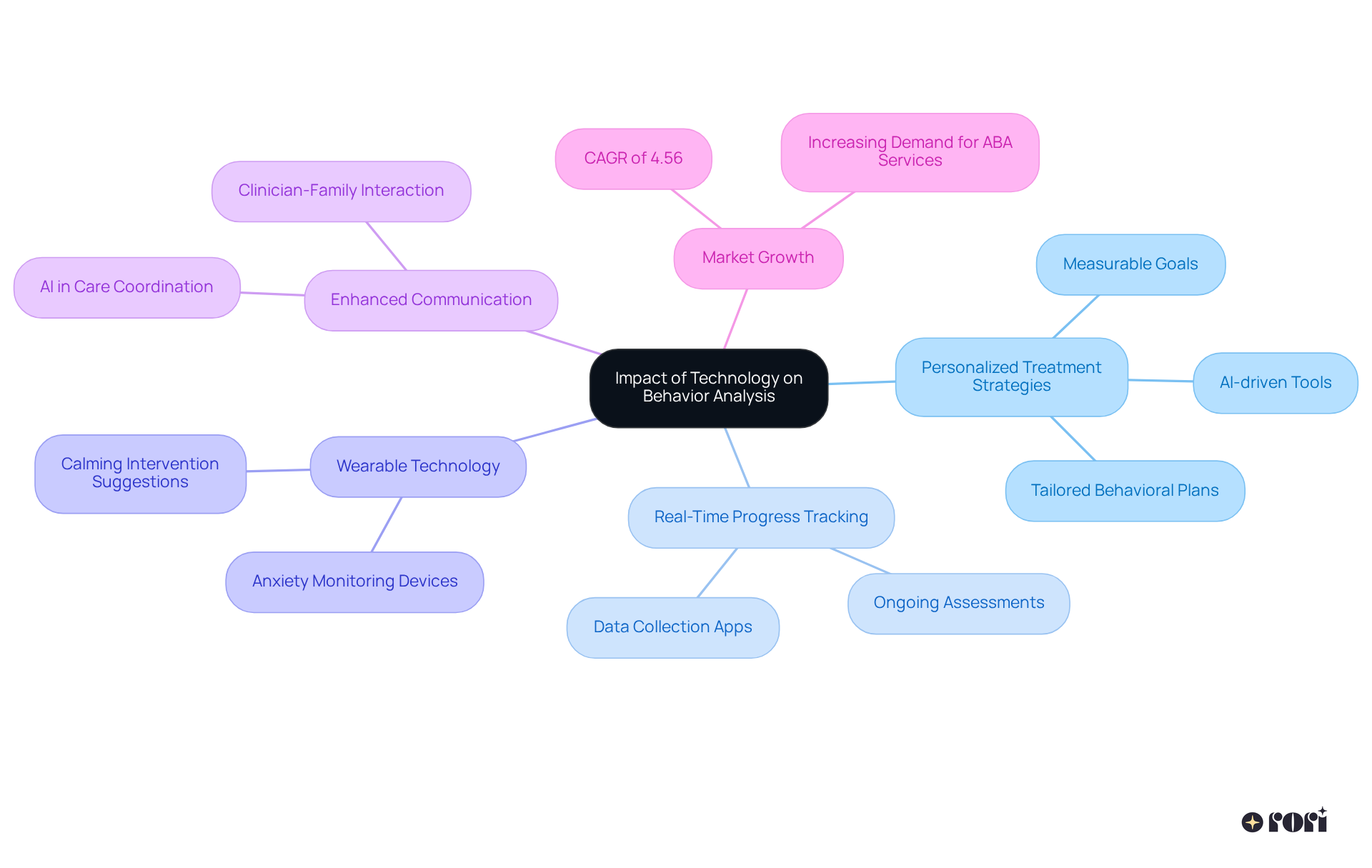This article offers a friendly look at the important role of behavior analysts, especially in autism care through Applied Behavior Analysis (ABA) therapy. It’s fascinating to see how behavior analysts assess needs, craft personalized treatment plans, and work hand-in-hand with families and other professionals. Research shows that these effective interventions can really make a difference, significantly enhancing the quality of life for individuals with developmental disorders.
Let’s explore this together! By understanding the vital contributions of behavior analysts, we can appreciate how they support families on this journey. Their expertise not only helps in creating tailored approaches but also fosters collaboration that’s so essential in making a positive impact. We’re here to help you every step of the way!
The role of behavior analysts is becoming more and more essential in autism care, where their expertise in Applied Behavior Analysis (ABA) therapy is truly changing lives. By using data-driven methods, these dedicated professionals create personalized treatment plans that meet the unique needs of individuals with developmental disorders, helping them develop positive behaviors and essential skills.
But as the demand for behavior analysts grows—projected to increase by a staggering 58% in the coming years—what challenges do they encounter in their quest for effective interventions? Understanding the complexities of this profession not only highlights the skills needed but also sheds light on the emotional and physical demands placed on these compassionate individuals. Let’s explore this together!
A behavior analyst description outlines a specialized professional who utilizes the principles of behavior analysis to assist individuals, particularly those with developmental disorders such as autism. The behavior analyst description includes main tasks such as:
By using data-driven methods, a behavior analyst description enables analysts to evaluate how well their interventions are working, ensuring they meet each person's unique needs.
They work closely with families, educators, and other professionals to create a supportive environment that encourages positive behavior change and skill development. This teamwork is so important! Studies show that effective interventions can really boost outcomes for individuals with autism, helping them gain independence and improve their quality of life.
At Rori Care, we empower young individuals with the skills they need to navigate the world independently. In fact, we see notable progress in 90% of them when recommended hours are fully implemented with active caregiver involvement. Our conduct care engine performs functional analysis and generates automatic progress reports for clinician evaluation, making ABA therapy more efficient and freeing up 50% more time for child care.
Plus, we adjust treatment plans based on progress report data to ensure continuous improvement. The behavior analyst description has gained importance as the demand for analysts in conduct has surged, with a remarkable 58% increase in employment from 2023 to 2024, highlighting their essential role in autism care.
However, becoming a Board Certified Behavior Analyst (BCBA) takes a significant investment of time and money. It involves:
BCBAs also face emotional and physical challenges while working with clients, adding complexity to their roles. Additionally, they often train and supervise assistant behavior analysts and registered behavior technicians, which enhances the collaborative nature of their work.
Let’s explore this together! We’re here to help you every step of the way!

The behavior analyst description emphasizes the crucial role these professionals play in supporting children with developmental disorders, especially through the use of Applied Behavior Analysis (ABA) therapy at Rori Care. They team up with clinicians, BCBAs, and families to craft and implement treatment strategies that fit each child's unique needs. In the world of neurodiversity, specialists focus on enhancing communication, social skills, and adaptive behaviors while working to reduce challenging behaviors. The behavior analyst description highlights their expertise as vital in creating a structured and nurturing environment that fosters learning and growth, making them key players in successful autism interventions.
At Rori Care, analysts also empower caregivers with ABA principles. This means parents can actively support their child's developmental goals through shared knowledge, aligned strategies, and careful data collection. This collaborative approach, paired with cutting-edge AI technology for functional behavior analysis and automated progress reporting, boosts the effectiveness of ABA therapy. It allows for more time dedicated to treating children and encourages meaningful progress with active caregiver involvement. Let’s explore this journey together! We’re here to help you every step of the way!

Behavior analysis has its roots in the early 20th century, with influential psychologists like John B. Watson and B.F. Skinner paving the way. Watson focused on visible actions, laying the groundwork for the field, while Skinner introduced operant conditioning, a method that helps us understand how our actions are influenced by their outcomes. This evolution led to practical ways to modify behaviors, which aligns with the behavior analyst description and can be especially helpful for individuals with developmental disorders.
A significant milestone came in the 1960s with the introduction of Applied Behavior Analysis (ABA) therapy, which is detailed in the behavior analyst description. This was a game changer, providing a structured behavior analyst description that applies behavior analysis principles to enhance the lives of young individuals with developmental disorders. Research shows that nearly half of the children receiving intensive ABA therapy made impressive strides in their cognitive and educational outcomes. This reinforces the behavior analyst description of ABA as a premier, evidence-based method in developmental care.
As the years have gone by, the field has grown and adapted, incorporating insights from practitioners and families affected by autism to fine-tune its practices. Today, Rori Care - ABA Therapy is at the forefront, using innovative AI technology to streamline functional behavior analysis and generate progress reports for clinicians. This means caregivers can spend 50% more time focused on child care, while also gaining valuable ABA strategies to actively engage in their children's behavioral goals.
By providing families affected by autism with knowledge and empathy, Rori Care ensures that care is not only effective but also respectful and tailored to individual needs. Let’s explore this journey together and see how we can support your family every step of the way!

When we think about the behavior analyst description, a few key characteristics and skills come to mind. Their strong analytical abilities and excellent communication skills are crucial components of a behavior analyst description, along with a deep understanding of behavioral principles. These professionals are adept at gathering and analyzing data, which is essential for guiding care decisions, as detailed in the behavior analyst description in the realm of Applied Behavior Analysis (ABA) therapy. After all, each adaptive plan is tailored to meet the unique needs of individuals.
ABA therapy stands out as the only scientifically validated approach for autism that insurance supports, which really highlights its significance. It’s also crucial for a behavior analyst description to include demonstrating empathy and patience when engaging with young individuals and families. Did you know that 90% of youngsters show significant advancement when the recommended hours are fully executed with active caregiver participation? That's a powerful statistic!
Moreover, a behavior analyst description emphasizes the need for strong problem-solving abilities to adjust interventions based on personal progress and challenges. They often use functional behavior analysis and automatic progress report creation to enhance care efficiency. A commitment to continuous professional growth is vital too, especially as advancements in AI-driven progress report automation can free up 50% more time for direct treatment.
Understanding the importance of early intensive behavioral intervention (EIBI) is also essential for improving learning, verbal, and social skills in children with developmental disorders. So, let’s explore this together! We're here to help you every step of the way!

The behavior analyst description highlights how incorporating technology into behavioral analysis has truly transformed how practitioners support individuals with autism. With AI-driven tools and data analysis, specialists can craft personalized treatment strategies that cater to each child's unique needs, all while keeping an eye on their progress in real-time. For example, at Rori Care, each behavioral plan is carefully tailored to fit the child's specific strengths and challenges. Plus, measurable goals provide clear benchmarks for progress, making interventions even more effective.
Imagine wearable technology that tracks anxiety levels and suggests calming interventions—it can really make a difference! This not only helps reduce challenging behaviors but also boosts overall well-being. These innovations enhance the accuracy of interventions and foster better communication between clinicians and families, ensuring everyone is informed and involved in the care process. As Dr. Jane Smith puts it, 'As physicians obtain improved information, we’ll witness the rise of specialists who adopt a more knowledgeable and nuanced method to treating patients.'
Rori Care's ongoing assessment and adjustment of treatment strategies mean that changes are made based on real-time information, leading to better outcomes for children. The ABA market is projected to grow at a CAGR of 4.56% from 2025 to 2030, reflecting the increasing demand for effective interventions. As this field evolves, the behavior analyst description will increasingly highlight the crucial role of technology—especially AI—in shaping effective behavior analysis practices, ultimately paving the way for brighter futures for children with autism. Let’s explore this together and see how these advancements can support your journey!

The role of a behavior analyst is truly vital in autism care. They blend scientific principles with a compassionate touch, helping individuals with developmental disorders make meaningful behavioral improvements. Through thorough assessments and personalized treatment plans, behavior analysts cater to each child's unique needs, ultimately boosting their quality of life and independence.
Throughout this journey, we see the extensive responsibilities of behavior analysts. They collaborate with families and other professionals to create supportive environments. And let’s not forget how technology, especially AI-driven tools, has transformed the way these experts monitor progress and fine-tune interventions, ensuring care is both effective and efficient.
As the demand for behavior analysts grows, we must recognize their essential role in shaping the futures of children with autism. By investing in their training and embracing innovative practices, we can enhance the support provided to families and empower young individuals to thrive. Let’s explore this journey together! By working hand-in-hand, we can make a meaningful difference in the lives of those affected by developmental disorders. We’re here to help you every step of the way!
What is the role of a behavior analyst?
A behavior analyst utilizes the principles of behavior analysis to assist individuals, particularly those with developmental disorders such as autism, by conducting assessments, creating personalized treatment plans, implementing targeted interventions, and monitoring progress.
How do behavior analysts support individuals with autism?
Behavior analysts work closely with families, educators, and other professionals to create a supportive environment that encourages positive behavior change and skill development, which can improve independence and quality of life for individuals with autism.
What methods do behavior analysts use to evaluate interventions?
Behavior analysts use data-driven methods to assess the effectiveness of their interventions, ensuring that they meet each person's unique needs.
What is the significance of teamwork in behavior analysis?
Teamwork is crucial as it enhances the effectiveness of interventions, leading to better outcomes for individuals with autism, particularly when families and caregivers are actively involved in the process.
What are the educational requirements to become a Board Certified Behavior Analyst (BCBA)?
To become a BCBA, one must earn a master's degree in behavior analysis or a related field, complete supervised fieldwork, and pass the BCBA certification exam.
What challenges do behavior analysts face in their roles?
Behavior analysts may encounter emotional and physical challenges while working with clients, which adds complexity to their responsibilities.
How does Rori Care enhance the effectiveness of ABA therapy?
Rori Care uses cutting-edge AI technology for functional behavior analysis and automated progress reporting, allowing for more time dedicated to child care and encouraging meaningful progress with active caregiver involvement.
What is the employment outlook for behavior analysts?
There has been a significant increase in demand for behavior analysts, with a 58% rise in employment from 2023 to 2024, highlighting their essential role in autism care.